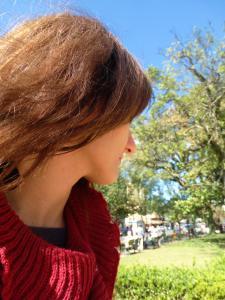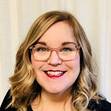Amy Sue Nathan's Blog: Women's Fiction Writers, page 25
April 24, 2015
About Face—What I See (And What I Don’t See) When I Write
I have no clue what my characters look like.
Okay, not 100% true. Just almost. I have no idea what their whole faces look like.
I do not clip pictures from magazines and glue stick them into a scrapbook, or have a Pinterest board filled with head shots. I don’t picture old neighbors or cousins or superstars when I write. I see beings, an aura, a movement. It’s as if the characters are traveling to fast for me to get a good look, or maybe I’m just so polite that I don’t want to stop them to stare. Even in a serious and intense scene, I don’t see faces.
Kinda creepy, now that I think of it.
I can glimpse the hair and see it messy or or coiffed. I know the color and style. I’m familiar with the character’s gait, shoulder width,and height. I certainly know if there’s a bump on a nose or a cleft in the chin. I define fashion sense. And sometimes I know eye color.
But I still don’t see faces.
When asked who would play my characters in a movie, I freeze. I don’t see my “people” on a screen, I see them on a page. Not that I’d reject a movie deal should Hollywood come to call, but I’d be more likely to say who I think could “pull off” the character rather than who looks like her.
When you meet Izzy Lane (for which I cannot wait!!) my main character in The Good Neighbor, you’ll know early on that her hair is short because her ex-husband always liked it long. I wrote Izzy tall (five-foot-nine) because that’s how I pictured her, with a gracefulness that I envision comes with long limbs. I don’t think I ever described the face of Izzy’s next-door-neighbor, Mrs. Feldman. She’s eighty-five. She’s spry. She speaks her mind. And she is also scared of a long-held secret. So, picture her as you want her to look. Like your favorite teacher, a grandmother, aunt or friend. Or leave her face peacefully blank, or always turned slightly away, filled in by story and emotion, not features.
In my work-in-progress, there’s a twelve-year-old girl. She is gangly in the way you know will turn into gracefulness in a few years, maybe more. She has long red hair and a tentative smile. I watched and recorded several cooking shows that featured kids, because I don’t have any twelve-year-old girls in my life and there were a few on the shows. One had just the right smile. Another was a little too grown up, but that was good to see. Another seemed a little too young. I noticed unplucked eyebrows and braces. Whimsy. Big smiles. Bigger tears. Those are the elements of a character to me, much more so than a portrait.
I write for myself, but my novels are published for my readers. I trust them to take good care of the characters, to allow the people on the page to be who the readers need them to be for that story—to look the part and be perfect for that reader only.
Do you picture faces when you read? Famous faces or everyday faces? If you’re a writer, who do you see when you write your own stories?








About Face���What I See (And What I Don’t See) When I Write
I have no��clue what my characters look like.
Okay, not 100% true. Just almost. I have no idea what their whole faces look like.
I do not clip pictures from magazines and glue stick them into a scrapbook, or have a Pinterest board filled with head shots. I don’t picture old neighbors or cousins or superstars when I write.��I see beings, an aura, a movement. ��It’s as if the characters are traveling��to fast for me to get a good look, or maybe I’m just so polite that I don’t want to stop them to stare. Even in a serious and intense scene, I don’t see faces.
Kinda creepy, now that I think of it.
I can glimpse the hair and see it messy or or coiffed. I know��the color and style. I’m familiar with the character’s gait, shoulder width,and height. I certainly know if there’s a bump on a nose or a cleft in the chin. I define fashion sense. And sometimes I know eye color.
But I still don’t see faces.
When asked who would play my characters in a movie, I freeze. I don’t see my “people” on a screen, I see them on a page. Not that I’d reject a movie deal should Hollywood come to call, but I’d be more likely to say who I think could “pull off” the character rather than who looks like her.
When you meet Izzy Lane (for which I cannot wait!!) my main character in The Good Neighbor, you’ll know early on that her hair is short because her ex-husband always liked it long.��I wrote Izzy tall (five-foot-nine)��because that’s how I pictured her, with a gracefulness that I envision comes with long limbs. I don’t think I ever described��the face of Izzy’s next-door-neighbor, Mrs. Feldman. She’s eighty-five. She’s spry. She speaks her mind. And she is also scared of a long-held secret. So, picture her as you want her to look. Like your favorite teacher, a grandmother, aunt or friend. Or leave her face peacefully blank, or always turned slightly away, filled in by story and emotion, not features.
In my work-in-progress, there’s a twelve-year-old girl. She is gangly in the way you know will turn into gracefulness in a few years, maybe more. She has long red hair and a tentative smile. I watched and recorded several cooking shows that featured kids, because I don’t have any twelve-year-old girls in my life and there were a few on the shows. One had just the right smile. Another was a little too grown up, but that was good to see. Another seemed a little too young. I noticed unplucked eyebrows and braces. Whimsy. Big smiles. Bigger tears. Those are the elements of a character to me, much more so than a portrait.
I write for myself, but my novels are published for my readers. I trust them to take good care of the characters, to allow the people on the page to be who the readers need them to be��for that story���to look the part and be perfect for��that reader only.
Do you picture faces when you read? Famous faces or everyday faces? ��If you’re a writer, who do you see when you write your own stories?








April 22, 2015
Guest Post: Author Lindsey J. Palmer Writes About Living In New York City And Major Life Milestones In Her New Novel
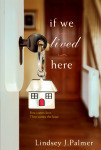 Today, author Lindsey J. Palmer poses a foreboding question: how do we���and our characters���handle major life changes? How about those milestone birthdays? (You know the ones.)In Lindsey’s newest novel, IF WE LIVED HERE, the main character, Emma, is on the cusp of turning��thirty. How does Emma cope? You’ll have to read the book to find out!
Today, author Lindsey J. Palmer poses a foreboding question: how do we���and our characters���handle major life changes? How about those milestone birthdays? (You know the ones.)In Lindsey’s newest novel, IF WE LIVED HERE, the main character, Emma, is on the cusp of turning��thirty. How does Emma cope? You’ll have to read the book to find out!
I have to admit that what impressed me even more than the premise (and I love books set in NYC because I love NYC) was the fact that Lindsey was writing her second published novel before she turned thirty.��
My debut was published in 2013 when I was forty-nine. When I was thirty I had a two-year-old and lived in an early nineteen-twenties Cape Cod in New Jersey. I had the��picket fence, both literally and figuratively.�� Times have changed.��
And I think that’s what IF WE LIVED HERE is about. Changing times. Adapting. Figuring things out along the way. Making it work. Living life.��
I can totally relate. Even if when I was thirty, there was no computer in my house, telephones were attached to walls, stamps cost twenty-nine cents���and people still used stamps.
Please welcome Lindsey J. Palmer back to WFW!
Amy xo
��
This Is 30: My Attempt To Capture A Milestone Age In Fiction
by Lindsey J. Palmer
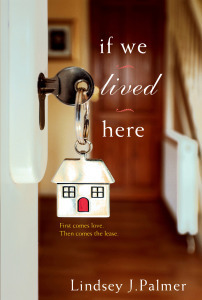 Here is a snapshot of my life, six months before I turned thirty: I���d recently moved in with my long-term boyfriend and, having decided to switch careers, was halfway through grad school, studying to become a high school English teacher. I���d just sold my first novel and felt equal parts excited and nervous for it to go out into the world. My inbox was a mix of friends��� wedding save-the-dates and baby announcements and other friends��� tales of Tinder first dates and one-night stands.
Here is a snapshot of my life, six months before I turned thirty: I���d recently moved in with my long-term boyfriend and, having decided to switch careers, was halfway through grad school, studying to become a high school English teacher. I���d just sold my first novel and felt equal parts excited and nervous for it to go out into the world. My inbox was a mix of friends��� wedding save-the-dates and baby announcements and other friends��� tales of Tinder first dates and one-night stands.
Before making the jump to a new career, I worked as a magazine editor and felt confident and successful at work. That all changed when I began training to teach: Suddenly I was brand new at a job with a steep learning curve, and not only were most of my grad school classmates nearly a decade younger, I also spent my days with teenagers���to them, someone pushing 30 was basically geriatric. As the resident elder in the room, I felt by turns wise and over-the-hill. I was starting from scratch, which was a thrill but also a struggle. Meanwhile, everywhere I turned, I felt bombarded by ���Top 30 under 30��� lists, those envy-breeding reminders of how much more successful than us other people are.
I also began to feel other pressures of growing older. Everyone from acquaintances to my dentist was suddenly asking me when I was going to get married already. People my age started talking to me about mortgages and baby carriages. The two trusty gray hairs I���d had since age sixteen suddenly multiplied���to ten, then a hundred, then too many to count.
Before this, I���d never thought much about my age. Birthdays were for cake and sparkling wine, not pondering the inevitable passage of time. But for the first time, my life felt so very in between���in between single and married, in between careers, in between unpublished and published, and in between the fickle fluctuations that had been my twenties and what I imagined to be a more stable, serious kind of adulthood���and I thought, well this must be thirty.
It was also six months before that milestone birthday when I sat down to write my second novel, If We Lived Here. I decided that I wanted the book to explore what it felt like to be that particular age, and specifically what it felt like to be a thirty-year-old woman living in a big city, someone ambitious but a bit ���in between.��� So I wrote my protagonist, Emma Feit, as a thirty-year-old New Yorker feeling unsettled in her career and planning to cohabitate with her boyfriend for the first time. Emma wasn���t me, but she was someone grappling with a lot of the same things I���d been grappling with. I planned to throw a bunch of obstacles in her way to test her understanding of herself as someone stumbling towards mature adulthood.
One element I had fun playing with in the novel is Emma���s obsession with Lily Bart, the protagonist of Edith Wharton���s famous 1905 novel, The House of Mirth. Similar to my book���s protagonist (and yes, to me, when I was creating Emma), The House of Mirth���s Lily Bart is an ambitious New Yorker pushing 30 and feeling unsettled with both her situation and her society���s strict standards for success. Although Wharton���s novel is set in a New York society a century earlier than my book���s (and my own), I was fascinated by how much remained the same���namely, the various pressures facing women around age thirty. Emma���s fascination with Lily Bart speaks to a certain timelessness of these issues.
As I got to know Emma better through my writing, I focused in on the questions I was most interested in exploring: How do the choices you make���in relationships, friendships, and career���affect the kind of adult you���ll become? How do you figure out what success and happiness mean to you, especially when the standard definitions don���t quite fit? And what does it look like to grow up and grow into different life stages at different rates than the people you love? Emma���s two best friends in the novel, both also thirty, represent two different life stages: Genevieve is a single actress struggling to pay her rent, whereas Annie has just settled into her new husband���s multimillion-dollar home and luxury lifestyle. Emma���s life lies somewhere in the middle.
There are countless ways to be thirty, of course. But creating Emma���s character helped me realize that there���s something universal about this milestone that prompts many thirty-year-olds to step back and examine our careers, our romantic lives, our friendships, and other aspects of ourselves, and how we���re combining all of these elements to build our own personal definitions of ���grown-up.��� My hope with If We Lived Here is, whether readers are themselves on the brink of the big THREE-O or many years from it (on either end of the spectrum), that they���ll identify with the larger question of how we reconcile a marker like age with where we are in our lives.
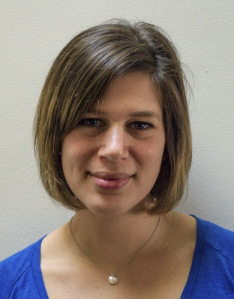 Lindsey J. Palmer worked as a professional writer and editor in the magazine industry for seven years,��most recently as Features Editor at Self, and previously at Redbook and Glamour. A graduate of the��University of Pennsylvania, she earned a Master of Arts in English Education from Teachers College,��Columbia University, and currently teaches 12th grade English and A.P. Literature in Manhattan. Lindsey��lives in Brooklyn with her fiance. Find��Lindsey at��lindseyjpalmer.com,��@lindseyjpalmer, and at��facebook.com/lindseyjpalmerauthor.��
Lindsey J. Palmer worked as a professional writer and editor in the magazine industry for seven years,��most recently as Features Editor at Self, and previously at Redbook and Glamour. A graduate of the��University of Pennsylvania, she earned a Master of Arts in English Education from Teachers College,��Columbia University, and currently teaches 12th grade English and A.P. Literature in Manhattan. Lindsey��lives in Brooklyn with her fiance. Find��Lindsey at��lindseyjpalmer.com,��@lindseyjpalmer, and at��facebook.com/lindseyjpalmerauthor.����
Buy If We Lived Here��at��IndieBound, on��Amazon,��or on��Barnes & Noble, and read a sneak-peek excerpt��here.








April 21, 2015
Guest Post: Author Susan Örnbratt Asks: “What is a lucky writer?”
 Here is a lovely reminder from author Susan Örnbratt that we should find inspiration in the everyday as well as in the extraordinary. And, that sometimes things happen just when they should. Even if it’s ten years later. Please welcome Susan to Women’s Fiction Writers!
Here is a lovely reminder from author Susan Örnbratt that we should find inspiration in the everyday as well as in the extraordinary. And, that sometimes things happen just when they should. Even if it’s ten years later. Please welcome Susan to Women’s Fiction Writers!
Amy xo
How a Grandmother’s Secret Words Became a Granddaughter’s Treasure
by Susan Örnbratt 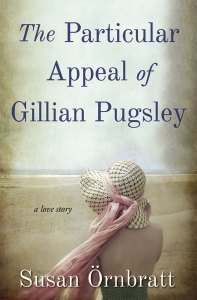 What is a lucky writer? Is it one who attends the best school with the best writing programme? Is it one who starts telling stories before she learns how to write? Is it one who writes her first novel and manages to get pulled from the slush pile, noticed and offered what we all want – the opportunity to publish? Or can it be as simple as a gift of words from one generation to another? I like to believe that grandmothers see something that we cannot. It’s as though they have an ability to wash away all life’s bits—the dirt that clouds our vision. When we doubt ourselves as writers, somehow they never do. Grandmothers see the heart of it, what’s really there. I can imagine my grandmother standing in a field of life’s debris, everything scattered around her; her mistakes, her worries, her indulgences, her vanity, her moments of envy and her need for approval, maybe even self-satisfaction and courage. The only structures still in tact are her passions; the people whom she adored, her dogs and The Lord. She was a devout Catholic. Yet standing tall on the horizon are her poems, one after another like city skyscrapers untouched yet powerful. In 2003, I was an on-again-off-again writer. I had written several children’s books and had completed my first novel a few years before – none of them garnering results. I hadn’t realized at the time the immense value in their training ground. Each writing project was overshadowed by a demanding career as a teacher. With all of my life’s debris floating around me, I couldn’t have known that my grandmother was waiting for the right time to shoo it all away. All along, when I thought no one had noticed my writing, what I enjoyed most in this world, there was someone in the wings watching every move. That’s what grandmothers do, just as I have a sneaking suspicion that every writer out there has someone watching. Whether you dabble in prose on weekends or coffee breaks in the staffroom, whether you submit that extra writing piece along with your art project at university, someone is noticing. I am sure of it. When my grandmother gave me the incredible gift of her poems just weeks before she died of cancer—cancer that she wasn’t actually aware of at the time, I remember holding them feeling bewildered and full of questions. These were poems that she had spent her life writing, yet all she would tell me was that no one had ever known about them. It was an incomprehensible treasure. Before handing them to me, she cradled them against her chest, holding them like a newborn child, and said, “You are a writer, Susan, maybe you can do something with these one day.” I wasn’t sure why, but I shelved her gift and didn’t look at them for ten years. Perhaps it was grief. I simply didn’t know. It took finishing my second novel before it occurred to me, “It’s time. I have to read those poems.” It was in seeing her handwriting that her words flooded every part of me. Seeing the bits she had scratched out and replaced, were telling of her love and commitment to her writing. Each poem told a story about her, about the times, about young love in the face of war and the trials of a woman, a wife, a mother on the home front, waiting on British soil, praying that he will walk through the door again. Seeing the rough drafts worked into a finished product made me appreciate the written word on paper, the handwritten word. These poems were in essence the letters of her life, and oh, how romantic they were! So I weaved my grandma’s poems into a new novel, a story inspired by her exquisite poems in her beautiful handwriting, The Particular Appeal of Gillian Pugsley. The exciting part is, even after death, my grandmother’s poems combined with my storytelling made a publisher sit up and notice. Together, we did it. It wasn’t until I was knee-deep in my novel that I understood why I had waited so long to read her poems—I wasn’t ready to write this story. We, as writers, find inspiration in a myriad of places. It can be found in the tiniest droplet of water on a twig whilst taking a walk, and still we feel lucky for being given that moment. So what makes for a lucky writer? I think we should all ask ourselves that question from time to time. Can it be as simple as a gift of words from one generation to the next? When I think of my grandmother and the treasure trove that her words unfolded in my imagination, the answer is crystal clear. Yes.
What is a lucky writer? Is it one who attends the best school with the best writing programme? Is it one who starts telling stories before she learns how to write? Is it one who writes her first novel and manages to get pulled from the slush pile, noticed and offered what we all want – the opportunity to publish? Or can it be as simple as a gift of words from one generation to another? I like to believe that grandmothers see something that we cannot. It’s as though they have an ability to wash away all life’s bits—the dirt that clouds our vision. When we doubt ourselves as writers, somehow they never do. Grandmothers see the heart of it, what’s really there. I can imagine my grandmother standing in a field of life’s debris, everything scattered around her; her mistakes, her worries, her indulgences, her vanity, her moments of envy and her need for approval, maybe even self-satisfaction and courage. The only structures still in tact are her passions; the people whom she adored, her dogs and The Lord. She was a devout Catholic. Yet standing tall on the horizon are her poems, one after another like city skyscrapers untouched yet powerful. In 2003, I was an on-again-off-again writer. I had written several children’s books and had completed my first novel a few years before – none of them garnering results. I hadn’t realized at the time the immense value in their training ground. Each writing project was overshadowed by a demanding career as a teacher. With all of my life’s debris floating around me, I couldn’t have known that my grandmother was waiting for the right time to shoo it all away. All along, when I thought no one had noticed my writing, what I enjoyed most in this world, there was someone in the wings watching every move. That’s what grandmothers do, just as I have a sneaking suspicion that every writer out there has someone watching. Whether you dabble in prose on weekends or coffee breaks in the staffroom, whether you submit that extra writing piece along with your art project at university, someone is noticing. I am sure of it. When my grandmother gave me the incredible gift of her poems just weeks before she died of cancer—cancer that she wasn’t actually aware of at the time, I remember holding them feeling bewildered and full of questions. These were poems that she had spent her life writing, yet all she would tell me was that no one had ever known about them. It was an incomprehensible treasure. Before handing them to me, she cradled them against her chest, holding them like a newborn child, and said, “You are a writer, Susan, maybe you can do something with these one day.” I wasn’t sure why, but I shelved her gift and didn’t look at them for ten years. Perhaps it was grief. I simply didn’t know. It took finishing my second novel before it occurred to me, “It’s time. I have to read those poems.” It was in seeing her handwriting that her words flooded every part of me. Seeing the bits she had scratched out and replaced, were telling of her love and commitment to her writing. Each poem told a story about her, about the times, about young love in the face of war and the trials of a woman, a wife, a mother on the home front, waiting on British soil, praying that he will walk through the door again. Seeing the rough drafts worked into a finished product made me appreciate the written word on paper, the handwritten word. These poems were in essence the letters of her life, and oh, how romantic they were! So I weaved my grandma’s poems into a new novel, a story inspired by her exquisite poems in her beautiful handwriting, The Particular Appeal of Gillian Pugsley. The exciting part is, even after death, my grandmother’s poems combined with my storytelling made a publisher sit up and notice. Together, we did it. It wasn’t until I was knee-deep in my novel that I understood why I had waited so long to read her poems—I wasn’t ready to write this story. We, as writers, find inspiration in a myriad of places. It can be found in the tiniest droplet of water on a twig whilst taking a walk, and still we feel lucky for being given that moment. So what makes for a lucky writer? I think we should all ask ourselves that question from time to time. Can it be as simple as a gift of words from one generation to the next? When I think of my grandmother and the treasure trove that her words unfolded in my imagination, the answer is crystal clear. Yes. 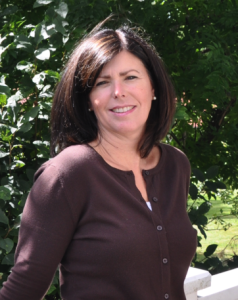 Susan Örnbratt was born in London, Canada and grew up on the dance floor until her brother’s high school rowing crew needed a coxswain. Quickly, she traded in her ballet shoes for a megaphone as rowing filled all of Susan’s time outside of school while competing in regattas across Canada and the US. When she was 16, Susan became a member of the Junior National Rowing Team and went on to compete in the Junior and Senior World Championships and the XIII Commonwealth Games in Edinburgh, Scotland. A graduate from the University of Western Ontario in French and the University of Manitoba in elementary education, as well as attending L’Université Blaise Pascal Clermont-Ferrand II in France while she worked as a fille au pair, Susan has gone on to teach and live in six countries. Although a maple leaf will forever be stitched on her heart, she has called Sweden her home for the past sixteen years with a recent three-year stint in North Carolina, USA for her husband’s work. It was there, where Susan wrote her second and third novels while achieving her long time goal of signing with a publisher for The Particular Appeal of Gillian Pugsley. Susan lives in Gothenburg, Sweden with her husband and two children and an apple tree nibbled on by the local moose population. If she isn’t shooing away the beasts, you can find her in her garden with some pruning shears, a good book and always a cup of tea. If Susan were dried out, she could be brewed. Susan’s website: http://susanornbratt.com
Susan Örnbratt was born in London, Canada and grew up on the dance floor until her brother’s high school rowing crew needed a coxswain. Quickly, she traded in her ballet shoes for a megaphone as rowing filled all of Susan’s time outside of school while competing in regattas across Canada and the US. When she was 16, Susan became a member of the Junior National Rowing Team and went on to compete in the Junior and Senior World Championships and the XIII Commonwealth Games in Edinburgh, Scotland. A graduate from the University of Western Ontario in French and the University of Manitoba in elementary education, as well as attending L’Université Blaise Pascal Clermont-Ferrand II in France while she worked as a fille au pair, Susan has gone on to teach and live in six countries. Although a maple leaf will forever be stitched on her heart, she has called Sweden her home for the past sixteen years with a recent three-year stint in North Carolina, USA for her husband’s work. It was there, where Susan wrote her second and third novels while achieving her long time goal of signing with a publisher for The Particular Appeal of Gillian Pugsley. Susan lives in Gothenburg, Sweden with her husband and two children and an apple tree nibbled on by the local moose population. If she isn’t shooing away the beasts, you can find her in her garden with some pruning shears, a good book and always a cup of tea. If Susan were dried out, she could be brewed. Susan’s website: http://susanornbratt.com








Guest Post: Author Susan ��rnbratt Asks: “What is a lucky writer?”
 Here is a lovely reminder from author��Susan ��rnbratt that we should find inspiration in the everyday as well as in the extraordinary. And, that sometimes things happen just when they should. Even if it’s ten years later. Please welcome Susan to Women’s Fiction Writers!
Here is a lovely reminder from author��Susan ��rnbratt that we should find inspiration in the everyday as well as in the extraordinary. And, that sometimes things happen just when they should. Even if it’s ten years later. Please welcome Susan to Women’s Fiction Writers!
Amy xo
How a Grandmother���s Secret Words Became a Granddaughter���s Treasure��
by Susan ��rnbratt  What is a lucky writer? Is it one who attends the best school with the best writing programme? Is it one who starts telling stories before she learns how to write? Is it one who writes her first novel and manages to get pulled from the slush pile, noticed and offered what we all want ��� the opportunity to publish? Or can it be as simple as a gift of words from one generation to another? I like to believe that grandmothers see something that we cannot. It���s as though they have an ability to wash away all life���s bits���the dirt that clouds our vision. When we doubt ourselves as writers, somehow they never do. Grandmothers see the heart of it, what���s really there. I can imagine my grandmother standing in a field of life���s debris, everything scattered around her; her mistakes, her worries, her indulgences, her vanity, her moments of envy and her need for approval, maybe even self-satisfaction and courage. The only structures still in tact are her passions; the people whom she adored, her dogs and The Lord. She was a devout Catholic. Yet standing tall on the horizon are her poems, one after another like city skyscrapers untouched yet powerful. In 2003, I was an on-again-off-again writer. I had written several children���s books and had completed my first novel a few years before ��� none of them garnering results. I hadn���t realized at the time the immense value in their training ground. Each writing project was overshadowed by a demanding career as a teacher. With all of my life���s debris floating around me, I couldn���t have known that my grandmother was waiting for the right time to shoo it all away. All along, when I thought no one had noticed my writing, what I enjoyed most in this world, there was someone in the wings watching every move. That���s what grandmothers do, just as I have a sneaking suspicion that every writer out there has someone watching. Whether you dabble in prose on weekends or coffee breaks in the staffroom, whether you submit that extra writing piece along with your art project at university, someone is noticing. I am sure of it. When my grandmother gave me the incredible gift of her poems just weeks before she died of cancer���cancer that she wasn���t actually aware of at the time, I remember holding them feeling bewildered and full of questions. These were poems that she had spent her life writing, yet all she would tell me was that no one had ever known about them. It was an incomprehensible treasure. Before handing them to me, she cradled them against her chest, holding them like a newborn child, and said, ���You are a writer, Susan, maybe you can do something with these one day.��� I wasn���t sure why, but I shelved her gift and didn���t look at them for ten years. Perhaps it was grief. I simply didn���t know. It took finishing my second novel before it occurred to me, ���It���s time. I have to read those poems.��� It was in seeing her handwriting that her words flooded every part of me. Seeing the bits she had scratched out and replaced, were telling of her love and commitment to her writing. Each poem told a story about her, about the times, about young love in the face of war and the trials of a woman, a wife, a mother on the home front, waiting on British soil, praying that he will walk through the door again. Seeing the rough drafts worked into a finished product made me appreciate the written word on paper, the handwritten word. These poems were in essence the letters of her life, and oh, how romantic they were! So I weaved my grandma���s poems into a new novel, a story inspired by her exquisite poems in her beautiful handwriting, The Particular Appeal of Gillian Pugsley. The exciting part is, even after death, my grandmother���s poems combined with my storytelling made a publisher sit up and notice. Together, we did it. It wasn���t until I was knee-deep in my novel that I understood why I had waited so long to read her poems���I wasn���t ready to write this story. We, as writers, find inspiration in a myriad of places. It can be found in the tiniest droplet of water on a twig whilst taking a walk, and still we feel lucky for being given that moment. So what makes for a lucky writer? I think we should all ask ourselves that question from time to time. Can it be as simple as a gift of words from one generation to the next? When I think of my grandmother and the treasure trove that her words unfolded in my imagination, the answer is crystal clear. Yes.
What is a lucky writer? Is it one who attends the best school with the best writing programme? Is it one who starts telling stories before she learns how to write? Is it one who writes her first novel and manages to get pulled from the slush pile, noticed and offered what we all want ��� the opportunity to publish? Or can it be as simple as a gift of words from one generation to another? I like to believe that grandmothers see something that we cannot. It���s as though they have an ability to wash away all life���s bits���the dirt that clouds our vision. When we doubt ourselves as writers, somehow they never do. Grandmothers see the heart of it, what���s really there. I can imagine my grandmother standing in a field of life���s debris, everything scattered around her; her mistakes, her worries, her indulgences, her vanity, her moments of envy and her need for approval, maybe even self-satisfaction and courage. The only structures still in tact are her passions; the people whom she adored, her dogs and The Lord. She was a devout Catholic. Yet standing tall on the horizon are her poems, one after another like city skyscrapers untouched yet powerful. In 2003, I was an on-again-off-again writer. I had written several children���s books and had completed my first novel a few years before ��� none of them garnering results. I hadn���t realized at the time the immense value in their training ground. Each writing project was overshadowed by a demanding career as a teacher. With all of my life���s debris floating around me, I couldn���t have known that my grandmother was waiting for the right time to shoo it all away. All along, when I thought no one had noticed my writing, what I enjoyed most in this world, there was someone in the wings watching every move. That���s what grandmothers do, just as I have a sneaking suspicion that every writer out there has someone watching. Whether you dabble in prose on weekends or coffee breaks in the staffroom, whether you submit that extra writing piece along with your art project at university, someone is noticing. I am sure of it. When my grandmother gave me the incredible gift of her poems just weeks before she died of cancer���cancer that she wasn���t actually aware of at the time, I remember holding them feeling bewildered and full of questions. These were poems that she had spent her life writing, yet all she would tell me was that no one had ever known about them. It was an incomprehensible treasure. Before handing them to me, she cradled them against her chest, holding them like a newborn child, and said, ���You are a writer, Susan, maybe you can do something with these one day.��� I wasn���t sure why, but I shelved her gift and didn���t look at them for ten years. Perhaps it was grief. I simply didn���t know. It took finishing my second novel before it occurred to me, ���It���s time. I have to read those poems.��� It was in seeing her handwriting that her words flooded every part of me. Seeing the bits she had scratched out and replaced, were telling of her love and commitment to her writing. Each poem told a story about her, about the times, about young love in the face of war and the trials of a woman, a wife, a mother on the home front, waiting on British soil, praying that he will walk through the door again. Seeing the rough drafts worked into a finished product made me appreciate the written word on paper, the handwritten word. These poems were in essence the letters of her life, and oh, how romantic they were! So I weaved my grandma���s poems into a new novel, a story inspired by her exquisite poems in her beautiful handwriting, The Particular Appeal of Gillian Pugsley. The exciting part is, even after death, my grandmother���s poems combined with my storytelling made a publisher sit up and notice. Together, we did it. It wasn���t until I was knee-deep in my novel that I understood why I had waited so long to read her poems���I wasn���t ready to write this story. We, as writers, find inspiration in a myriad of places. It can be found in the tiniest droplet of water on a twig whilst taking a walk, and still we feel lucky for being given that moment. So what makes for a lucky writer? I think we should all ask ourselves that question from time to time. Can it be as simple as a gift of words from one generation to the next? When I think of my grandmother and the treasure trove that her words unfolded in my imagination, the answer is crystal clear. Yes.  Susan ��rnbratt��was born in London, Canada and grew up on the dance floor until her brother���s high school rowing crew needed a coxswain. Quickly, she traded in her ballet shoes for a megaphone as rowing filled all of Susan���s time outside of school while competing in regattas across Canada and the US. When she was 16, Susan became a member of the Junior National Rowing Team and went on to compete in the Junior and Senior World Championships and the XIII Commonwealth Games in Edinburgh, Scotland. A graduate from the University of Western Ontario in French and the University of Manitoba in elementary education, as well as attending L���Universit�� Blaise Pascal Clermont-Ferrand II in France while she worked as a fille au pair, Susan has gone on to teach and live in six countries. Although a maple leaf will forever be stitched on her heart, she has called Sweden her home for the past sixteen years with a recent three-year stint in North��Carolina, USA for her husband���s work. It was there, where Susan wrote her second and third novels while achieving her long time goal of signing with a publisher for The Particular Appeal of Gillian Pugsley. Susan lives in Gothenburg, Sweden with her husband and two children and an apple tree nibbled on by the local moose population. ��If she isn���t shooing away the beasts, you can find her in her garden with some pruning shears, a good book and always a cup of tea. If Susan were dried out, she could be brewed. Susan’s website:��http://susanornbratt.com
Susan ��rnbratt��was born in London, Canada and grew up on the dance floor until her brother���s high school rowing crew needed a coxswain. Quickly, she traded in her ballet shoes for a megaphone as rowing filled all of Susan���s time outside of school while competing in regattas across Canada and the US. When she was 16, Susan became a member of the Junior National Rowing Team and went on to compete in the Junior and Senior World Championships and the XIII Commonwealth Games in Edinburgh, Scotland. A graduate from the University of Western Ontario in French and the University of Manitoba in elementary education, as well as attending L���Universit�� Blaise Pascal Clermont-Ferrand II in France while she worked as a fille au pair, Susan has gone on to teach and live in six countries. Although a maple leaf will forever be stitched on her heart, she has called Sweden her home for the past sixteen years with a recent three-year stint in North��Carolina, USA for her husband���s work. It was there, where Susan wrote her second and third novels while achieving her long time goal of signing with a publisher for The Particular Appeal of Gillian Pugsley. Susan lives in Gothenburg, Sweden with her husband and two children and an apple tree nibbled on by the local moose population. ��If she isn���t shooing away the beasts, you can find her in her garden with some pruning shears, a good book and always a cup of tea. If Susan were dried out, she could be brewed. Susan’s website:��http://susanornbratt.com








April 17, 2015
This Is My Brain On Index Cards
I could not remember the dead friend’s��last name.
I realize this is a problem likely reserved for novelists, because if I had a dead friend, I’d probably recall her last name.
At that point I hadn’t written many pages of my third novel yet, but I had an outline and a short synopsis for my agent, and ideas jotted down on paper just for me. I rifled through all of it.
Cooper.
The last name was Cooper.
I intentionally choose simple last names but obviously THAT memory trick didn’t work this time. I was going to have to figure out something so that this story, the new one, didn’t have me scrolling through pages to remember every name and every eye color.
So you know what this meant. A trip to the corner Walgreens.
There is not a plethora of index cards in Walgreens, but when I’m on a writing roll I am not prone to a shopping trip. So I worked with what I had. I chose the large, white cards because in a moment of stark realism, I know the small ones would not give me enough space because my ideas come out sideways and in large loopy letters, not neatly, and not on little blue lines.
I must say I was disappointed with the quality of the cards. They were more like paper than cards, but I was determined. I wrote each character’s name at the top, and anything I knew about him or her. Boys in blue. Girls in pink. I didn’t have check list or a method, I just jotted down what I knew about the character, mostly things like all their names (middle, maiden, nick���you get the idea), eye color, hair color and style, short or tall, thin or fat, and maybe his or her relationship to another character. I wrote the things that needed to remain consistent through the story, the things that wouldn’t change. Maybe for this novel’s first draft I wouldn’t have to type “find out what color Celia’s eyes were” on page 86, because I’d have a card that told me what i needed to know. I would limit my scrolling backwards and increase my moving forward. And in story writing, that is a good thing.
But I had more cards. What to do?
I don’t use the common novel-writing lingo because it doesn’t work for me. I’m a rebel that way. I find the words CONFLICT and TENSION empty. I look at them and think HUH? But, I do understand WORRY and ANGRY and SCARED and WONDER and SECRET and WANT and NEED. ��So I wrote those out on cards for each character. Not in any order. Not the same for each one. Just what I knew to be important. Just what I knew at that time. That’s the great thing about index cards. There are always more.
I also put the major story points on cards. And���I wrote words you’re not supposed to write. AND THEN. That works for me. I wrote each major and minor event (you say plot point, I say event) on an index card followed by the words AND THEN…. This allowed me to consider the flow, and what was happening when and to move things around without major cutting and pasting in my Word doc.
I also wrote themes of the story on cards, and I’ll likely transfer those to���you guessed it���Post It Notes, when it’s time for me to revise. Those will stick all over my computer reminding me of what needs to float beneath the story to give it buoyancy.
For a few weeks I had each stack neatly paper-clipped together and tucked into an adorable little case I could carry around and look all writerly. Then one��day I was chatting with my lovely agent and she asked, “What’s the last name of the dead friend again?” (No joke, she really did. She was writing up little blurb for the new book.)
“Oh my god,” I said. “I forget.”
“Well, call me when you remember.”
And then I did remember.
“I have index cards!”
And yes, the last name was still Cooper.
That’s when I realized index cards do not belong in pretty pouches. I wanted the cards out and around me��whether I’m on the sofa or in bed (rules out the desk, but I don’t write there anyway).
The cards are like a little pat on the back to myself.��I’ve thought it through, I have a plan, there is sense and order where I often feel there’s none. Even on days I get no writing done, I can read a card or two and have a good sense of story, remember something old, think of something new, and add a card to the pile.
I had no roadmap at all for The Glass Wives. When I wrote my debut novel I outlined the Chapter 3 when I finished Chapter 2. Yep, that book took four years to write. Not happening again. Ever. When I wrote The Good Neighbor I started with a (take a deep breath) twenty page synopsis. That synopsis served only as a loose tether to the story, because 1) stories always change as you write them, and 2) who is going through twenty pages to remember what’s just happened, what’s happening now, and what happens next? Not me.
The index cards are manageable size bites of the story and the characters, They’re snippets of time and place, fragments of intention and emotion. And on those days all writers have when the gifts of the writing life are elusive, when the rewards��seem improbable and the words are fuzzy, these index cards are tangible rectangular reminders that many thoughts have been already been thought, and much of the work has already been done.
Cooper.








April 16, 2015
Author Interview: Anita Hughes Takes Readers To France With An Exotic And Fun Summer Read
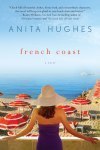 Today I’m pleased to welcome Anita Hughes back to Women’s Fiction Writers! Her newest novel, FRENCH COAST, whisks you far away without leaving the comfort of your favorite chair. Or bed. Or beach blanket. Anita shares with us how she chose the location for FRENCH COAST, and offers advice on choosing character names when you’ve used your favorites for your children (and Anita has five children)! I’ve known Anita since before our debut novels were published, and she’s as lovely as she is prolific. FRENCH COAST is her fourth novel!
Today I’m pleased to welcome Anita Hughes back to Women’s Fiction Writers! Her newest novel, FRENCH COAST, whisks you far away without leaving the comfort of your favorite chair. Or bed. Or beach blanket. Anita shares with us how she chose the location for FRENCH COAST, and offers advice on choosing character names when you’ve used your favorites for your children (and Anita has five children)! I’ve known Anita since before our debut novels were published, and she’s as lovely as she is prolific. FRENCH COAST is her fourth novel!
Please welcome Anita to Women’s Fiction Writers!
Amy xo
Author Anita Hughes Takes Readers To France With An Exotic And Fun Summer Read
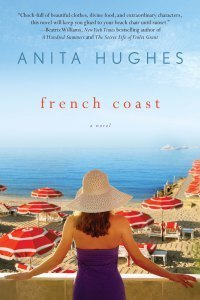 Amy: Your novels are set in interesting and exotic locations. Do you spin the globe, close your eyes, and point? How did you choose the location for French Coast and your other novels?
Amy: Your novels are set in interesting and exotic locations. Do you spin the globe, close your eyes, and point? How did you choose the location for French Coast and your other novels?
Anita: I chose the location of French Coast because I have always loved the French Riviera and Cannes. When I was young, my mother, who was European, always talked about the Carlton-Intercontinental in Cannes. I also watched How To Catch A Thief with Cary Grant and Grace Kelly a few times. It is set at the Carlton and it is one of my favorite movies. When I pick a location, I think where I want to spend the next few months, because while I’m writing I feel like I’m there. Then I pull up images on the internet and soak them in.
Amy: I have names on the brain since I’m writing a new novel and still deciding on some character names. How did you arrive at the names for some of your characters in French Coast?��
Anita: Names can be a challenge, especially after you’ve written a few books! I have five children and I can’t use any of their names. I usually just let names come to me, but they really have to fit the characters. I sit with them for a few days and if it feels right, I start writing. A sign that a name is right is if I start not being able to imagine my characters having any other names – a bit like my own children.
Amy: Have you ever used the name of someone you know, even if the character was nothing like him or her? Can you tell us about that. (I do that sometimes, as a little nod to someone important.)
Anita: I think I have used names of movie stars but no real people. But that’s a lovely idea – to give a nod to someone important!
Amy: I know you’re a fast writer���so what’s your secret? Do you outline or do you write and see where the story takes you? What is planned out in your stories and what do you allow to happen organically?
Anita: I do an outline for my publisher and that helps me see the whole story and not feel lost. I definitely let the story go where it wants to and often have characters and plot lines that weren’t in the initial outline. I think some of the best work I do is not at the computer – I think about the story all the time and write what I’m going to write the next day in my head: complete with dialogue. Then when I sit down to write it is easy and I never have to think more than a day ahead.
Amy: What’s your best advice for aspiring authors of women’s fiction today?��
Anita: I think the best advice is always to read. I have always been a reader and still read a couple of books a week. I think the most important thing to develop as an author (especially of women’s fiction) is a voice. You want your reader to want to spend time with your characters and care about them and the way to do that is through voice. Developing a voice comes from spending a lot of time at the keyboard until you feel confident in your writing and can really let the characters take over.
Thank you for having me on your wonderful blog, Amy! You are a real inspiration and guide to authors of women’s fiction.
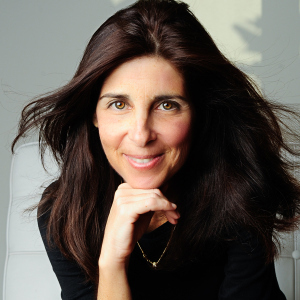 Anita Hughes was born in Sydney, Australia. At the age of eight, she won first prize in a nationwide writing contest sponsored by THE AUSTRALIAN, Australia’s most prestigious newspaper. She graduated from Bard College with a B.A. in English Literature and a minor in Creative Writing, and attended UC Berkeley’s Masters in Creative Writing Program. She lives at The St. Regis Monarch Beach, where she is at work on her next novel.
Anita Hughes was born in Sydney, Australia. At the age of eight, she won first prize in a nationwide writing contest sponsored by THE AUSTRALIAN, Australia’s most prestigious newspaper. She graduated from Bard College with a B.A. in English Literature and a minor in Creative Writing, and attended UC Berkeley’s Masters in Creative Writing Program. She lives at The St. Regis Monarch Beach, where she is at work on her next novel.
https://twitter.com/hughesanita
https://www.facebook.com/AnitaHughesBooks








April 8, 2015
Author Interview: Margaret Dilloway Shares A Story Of Estranged Sisters, A Secret Book, And Female Samurai
 Congratulations to Margaret Dilloway on the publication of her third novel, SISTERS OF HEART AND SNOW!��Swords, sisters, and secrets! What’s not to love?��
Congratulations to Margaret Dilloway on the publication of her third novel, SISTERS OF HEART AND SNOW!��Swords, sisters, and secrets! What’s not to love?��
Please welcome Margaret to WFW!
Amy xo��
Margaret Dilloway Shares A Story Of Estranged Sisters, A Secret Book, And Female�� Samurai
��
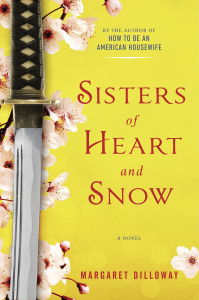 Amy:
��What sparked a novel that centers on estranged sisters?��
Amy:
��What sparked a novel that centers on estranged sisters?��
Margaret:��I have actually wanted to write about sisters for a while. HOW TO BE AN AMERICAN HOUSEWIFE originally had sisters in it, until it became a mother-daughter story. And now that I’m a mother of two daughters and have witnessed how close they are– how they have their own special bond– I wondered what would happen to two adult sisters who lost that bond, and how devastating that would feel.
Amy: ��Also central to the story is the book the sister search for, and that story is offered separately from your novel. Did you intend to write a book that fit within the novel? Was it a daunting process to write two stories that are essentially part one larger story?��
Margaret:��No, I didn’t start out with the intention of writing an entire book that fit within the novel– I knew I’d have a book within a book, but I thought it’d be shorter.
The problem with writing a book incorporating something like this is the tendency to either have a huge story where the central theme gets lost because there are too many threads. So you have a long, but unsatisfactory story. Originally I had a lot of historical elements that, while interesting, kind of cast a shadow on the core of the story. So I cut it down the historical part, instead making it highlight the themes of the main story.
I had enough of the historical story left– including the POV of another character– to make its own standalone book. So it was my idea to make that book available, too.
Amy:�� I love culture as a ingredient in contemporary fiction. How did you decide which bit of Japanese culture, and a Japanese-American family would be integral to the story? Or did the story and characters tell you?��
Margaret:��I knew I wanted to write about female samurai because I never knew they existed! And I’m fascinated with the whole idea of tracing your ancestry and how finding out about your family tree, for good or bad, can affect how you feel.
Including the female warrior was the big chunk of Japanese culture I decided to include. The other parts were dictated by the characters. The girls are pretty much cut off from their heritage, except for some not great parts of it.
Amy: ��For the first time, I’m using index cards for characters, facts, and events while I’m writing my next novel. What’s your method for “keeping things straight” while you’re writing?��
Margaret:��Umm, does writing things on Post-It notes and sticking them all over my desk count as a system?��(Yes! Yes, it does!)��That’s pretty much been my system to date, but I’m working on making a character list sheet– like a cast list of a play– stating the characters’ birthdays, hair color, etc.
Amy: ��Do you have any new ideas or new books brewing that you can share?��
Margaret:��I don’t have any WF news to share yet. My next book out is actually going to be a middle grade book, XANDER AND THE LOST ISLAND OF MONSTERS, from Disney-Hyperion next year. It’s a fun, contemporary retelling of a classic Japanese tale, Momotaro the peach boy, about a boy who fights the demons who threaten the world.��(Congratulations!)
Amy: ��What’s your best advice for aspiring authors of women’s fiction?��
Margaret:��Find your unique voice, the thing that makes you you, and be you proudly.
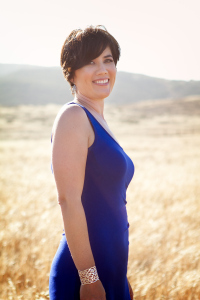
Photo credit Saflower Photography
Margaret Dilloway is the author of How to Be an American Housewife and The Care and Handling of Roses with Thorns. She teaches creative writing classes at San Diego Writers Ink and to high school students at her alma mater, and recently signed a 2-book deal with Disney-Hyperion for a middle-grade fantasy series that will be published in June 2016. Margaret lives in Southern California with her husband and their three children.
www.margaretdilloway.com
And if a novel isn’t enough���in a unique historical twist���Margaret’s main character, Tomoe Gozen, is based on��a real-life female samurai found in history, and she has family ties to Margaret��herself. The complete story of Tomoe is available as a full-length eBook:��THE TALE OF THE WARRIOR GEISHA.








April 6, 2015
Author Interview: Author Holly Robinson Talks About Emotion, Mystery, and Names���Oh My!
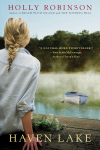 Sometimes you just click with someone, and that’s how it was for me and my friend, author Holly Robinson. I’m not sure even how or when we first connected, likely due to her first novel with NAL, The Wishing Hill, which was published around the same time as The Glass Wives. TODAY, Holly is launching her third novel with NAL, HAVEN LAKE (and has another coming out in the Fall, OMG). The best part of interviewing an author-friend is learning new things about her, her writing, her stories. They’re not usually the kinds of things that come up in casual phone conversations, but they’re the things I want to know and the kinds of interviews I want to share here.
Sometimes you just click with someone, and that’s how it was for me and my friend, author Holly Robinson. I’m not sure even how or when we first connected, likely due to her first novel with NAL, The Wishing Hill, which was published around the same time as The Glass Wives. TODAY, Holly is launching her third novel with NAL, HAVEN LAKE (and has another coming out in the Fall, OMG). The best part of interviewing an author-friend is learning new things about her, her writing, her stories. They’re not usually the kinds of things that come up in casual phone conversations, but they’re the things I want to know and the kinds of interviews I want to share here.
Actually, that’s the best part of interviewing anyone���quenching my own curiosity by getting the answers to MY questions and knowing what, how, and why those answers would be of interest to others. (Hello, Journalism Degree!!)
Holly’s novels are family dramas strewn with emotion and mystery. Family secrets are woven through each one, as well as vivid settings, and character voices that ring clear and true. You’ll see what I mean when you read the interview!��
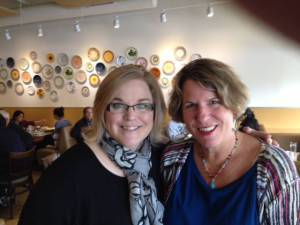
Amy and Holly and lots of plates on a wall���September 2014
Please welcome Holly Robinson back to WFW!
Amy xo
Author Holly Robinson Talks About Emotion, Mystery, and Names���Oh My!
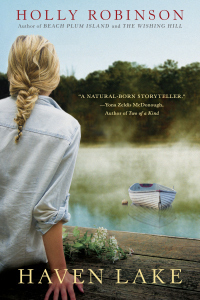 Amy: Is Haven Lake a real place or just a real place in the novel? I know all your novels are set in the same area of Massachusetts where you live. For Haven Lake, how did you decide on/come up with this specific setting?
Amy: Is Haven Lake a real place or just a real place in the novel? I know all your novels are set in the same area of Massachusetts where you live. For Haven Lake, how did you decide on/come up with this specific setting?
Holly: Haven Lake wasn’t a real place when I began the novel, but it feels very much like one now that I’ve created that world and lived in it. Setting plays a huge role in my books because I always feel that, by choosing the right setting, you can amplify the emotions in a novel. For instance, my first novel, The Wishing Hill, was set partly in Mexico and partly on the Massachusetts North Shore, because one of the characters in my novel is a painter who must travel between those two places as she tries to unravel the mystery of why the woman she thought is her mother is really someone else. I wanted the emotional shock she feels upon making that discovery to be painted in a very visual way on the page, by comparing the bright colors and heat of Mexico with the earthier, cooler tones of New England.
Likewise, Haven Lake has a dual setting: the Massachusetts North Shore and the Berkshires. Haven Lake is the name of the farm where two tragic deaths���a suicide and a mysterious drowning���occur that shatter the commune of people living there in the 1970s. Now, when one of the main characters, Sydney, has to return to Haven Lake, she is besieged by her childhood memories of this place. The dark pine woods, the stone walls, the pond, even the silhouette of the foothills around the farm all bring back memories, forcing Sydney to reexamine what really happened to cause those deaths���and her own life.
Amy: Let’s talk character names? Did you choose your characters’ names or did they come to you with their name tags on?
Holly: Ha! I wish I could say I had some ingenious way of devising names for my characters, but nope. Often the names are just names I like���names I didn’t get to use on my children, say, because my husband vetoed them, or names that evoke something because of what they mean. I have even been guilty of choosing short names because they’re so much less work to type.
(OMG, that’s the best thing I ever heard! LOL!)
Amy: Your novels are always intertwined with a little family mystery and secrets. Do you know the secret when you start writing? And what do you take into consideration when determining the secret, and its reveal?
Holly: I write what I call ���emotional family mysteries��� because I love to read mystery novels with great tension and forward momentum in the narrative. I also love reading literary fiction where the characters are fully developed, so that we can relate to them and develop new perspectives as we read about their conflicts and resolutions. I always know most of the secrets before I begin writing a novel for one simple reason: my editor requires me to write a synopsis before giving me a contract. When I consider what ���big secret��� is going to serve as the main plot line, I’m often inspired by true stories���often from my own family history, or from friends. The darker the better!
However, I should add that, even when I know the big secret in advance and have written a synopsis around it, there are always other secrets and smaller reveals that happen along the way, surprising even me. I keep writing for the same reason people love to read: to find out how the story ends.
Amy: I love the way Haven Lake has multiple points of view, including a teenage boy. Was this POV a challenge in any particular way?
Holly: I found writing from this point of view came naturally. I have a teenage son, and he and his friends are often hanging around my house or riding in my car, so I have lots of opportunities to pick up on their language. I love writing from multiple points of view, because every one of your characters can describe the other characters in the book. That saves you from the old ���she glanced in the mirror and saw that her long dark hair was…��� sort of tired trick when you have a single point of view.
Amy:��In terms of foreshadowing, which you do very well, what’s your best advice to other writers who want to reveal a secret but don’t want to give it all away too soon?
Holly: Always leave the reader wanting more! Typically, in my early drafts I overwrite my foreshadowing and flashbacks. These scenes are often clumped in the first half of the novel because I’m figuring things out as I write. During later drafts, I remove any flashback or foreshadowing I don’t absolutely need, and I try to distribute the essential bits infrequently enough that the reader is always being carried forward. My main objective is to keep the narrative tension high enough that the reader is compelled to keep turning pages long after she should turn the light out and go to sleep.
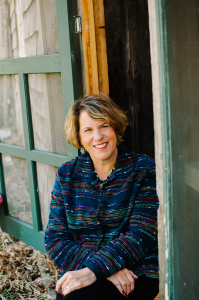 Novelist, journalist and celebrity ghost writer Holly Robinson is the author of several books, including The Gerbil farmer’s Daughter: A Memoir and the novels The Wishing Hill, Beach Plum Island and Haven Lake. Her articles and essays appear frequently in publications such as Cognoscenti, The Huffington Post, More, Parents, Redbook and dozens of other newspapers and magazines. She and her husband have five children and a stubborn Pekingese. They divide their time between Massachusetts and Prince Edward Island, and are crazy enough to be fixing up old houses one shingle at a time in both places. Find her at www.authorhollyrobinson.com and on Twitter @hollyrob1.
Novelist, journalist and celebrity ghost writer Holly Robinson is the author of several books, including The Gerbil farmer’s Daughter: A Memoir and the novels The Wishing Hill, Beach Plum Island and Haven Lake. Her articles and essays appear frequently in publications such as Cognoscenti, The Huffington Post, More, Parents, Redbook and dozens of other newspapers and magazines. She and her husband have five children and a stubborn Pekingese. They divide their time between Massachusetts and Prince Edward Island, and are crazy enough to be fixing up old houses one shingle at a time in both places. Find her at www.authorhollyrobinson.com and on Twitter @hollyrob1.

March 30, 2015
Self-Editing for Authors���Getting Rid of the Aww and the Awe
I often question my writing, judge my prose, belittle my word choices, and doubt my plot points. Some days I love what I���ve written.
The ���disbelieving me��� is in awe of the time and effort it will take to get from first draft to final draft. The ���believing me��� might think, ���Aww, this is so good it doesn���t need to be changed.
No! To both.
I must self-edit.
I also must strike a balance where I am confident in my work but know it needs work.
Whether it���s the first time or the hundredth time, self-editing can be daunting. At least it can be for me. I stare at the monitor and all this little black shapes stare back at me. Just looking at them is exhausting.
I know myself. I self-edit differently than I write. I���m a binge writer, but a bit-by-bit editor. Not that I can���t, or haven���t, edited for hours, but I can also edit a paragraph, then leave for an appointment or to do the dishes.
Oh, who am I kidding? I do not stop editing to do the dishes.
But I do stop if I���m overwhelmed.
The key here is not to get overwhelmed.
First Drafts
My first drafts are embarrassing. I write in sentence fragments and run-ons. But what I have when I���m finished, I hope, is the beginning, middle, and end of a chapter, the right idea to build upon. I write light in first drafts. That means I know I���m going to go in again to flesh out ideas. Many of my friends write 125, 000 word first drafts they edit down to 90,000 words. My finished first drafts are about 50,000 words. I edit up. No matter how you work, some of these tips might work for you to take the sting out of first draft editing.
Do it quickly. Later I���ll advocate stepping away, but with a first draft I want to capitalize on my momentum. I���ll write a scene or chapter and go back and self-edit the same day. Sometimes, same hour.
Don���t look back. For this draft I just go back in and change things with no mind to what was there before. I don���t want to remember the dreck, I want to revise it.
Dump what doesn���t work. I elaborate on my sentence fragments and cull my run-ons. I specific ���something like purple but not��� and write lavender or periwinkle.
Decide what does works. Or what doesn���t. This is usually the time I get a gut feeling at this time if the names I���m using really works for me. I also get a feeling about characters and if I need them. I want to move forward writing about what���s necessary.
Dialogue, dialogue, dialogue. This is where I clean it up. No one���s cursing (well, maybe a little), but in a first draft I type so fast I don���t always use proper formatting. I want to GET IT OUT. So I go back and tidy up. Appearances are everything (you���ll see why later).
Define the path. Is there a beginning, middle, and end of the chapter? If something���s missing I don���t write it, I make a note that it���s missing. Does the chapter ending leave a question or cliffhanger? If not, I consider how to make the chapter end so that the reader must turn the page. Have I buried anything in overwriting exuberance? (Who, me?)
My first draft isn���t really finished until it���s self-edited. Until I know someone else could read it and make sense of it, even with the weaknesses and holes. I call it my finished first draft. Before that, you don���t want to know what I call it.
Second Drafts (Or, to Infinity���And Beyond)
I have never counted drafts. Let���s say that with each of my novels (published, soon-to-be published, and under-the-bed) I���ve written more than two drafts and fewer than a hundred.
This, for me, is where fine-tuning begins and where I remember the best advice/joke I ever told my daughter.
���How do you eat an elephant?���
���One bite at a time.���
If I looked at a whole manuscript and imagined editing the whole thing on my own, I���d crawl under this bed I call an office and that would be that. But because I write, and edit, my novels a chapter at a time, at first, it���s more manageable to me. For the time being I pretend that���s all I need to worry about, which allows me to focus (ie: which eliminates panic).
Print out pages. Whether I���ve written the whole book or not, I print out one chapter. If you���re not a paper person, this is where I���d use track changes.
Get your hands dirty. Yes, I use multicolored markers. Yes, they end up on my hands. When I do Track Changes, I go into the options and make all the different kinds of changes different colors. Makes it fun.
One Bite At A Time. I go paragraph by paragraph and polish so that what���s going on there makes sense to me, and is tightly written, but I don���t go overboard. This is where I���d rather have too much than too little. This is where I start my editing up.
Read aloud. Especially dialogue. I tend to use characters��� names in dialogue until I edit it. I also use a lot of ���Well.��� Because, well, I just do.
Lay it out. I look at chapters by laying the pages side by side on my dining room table. I look for visual cues. Do the paragraphs all start with the same word? (A no-no) Are the sentences and paragraphs the same lengths page after page? How long are your dialogue runs? These are things you can consider when revising, because variations make stories more interesting.
Final Drafts
Final drafts take many forms. I have final drafts for my critique partner, then for agent, and then final drafts for my editor. If you���re not hiring an editor (silent scream) and you���re self-publishing then your final draft is for your reader.
For me, this is the detail and danger zone. This is where I nit-pick and where I usually am convinced that all my time and effort and energy has resulted in a big pile of poo. Luckily, this is normal. And that���s why I start with the hardest thing of all.
Step away. Unless I���m right up against a deadline, I leave the manuscript untouched for days or weeks if possible. This provides perspective. If I have an epiphany (in the shower or while driving, ���natch) I write it down but don���t open the Word doc.
Go slow. When it���s time to get back to work, I start again by tackling one chapter at a time. I read for content and clarity. I circle or highlight what I need to come back to.
Be honest. I note overused words and clich��s. No one is above using them. Now is the time to get rid of them. Then, I do a search for any crutch words. Every writer has them. I use ���and��� more times than should be legal. I also make note of lingo and colloquialisms that might not work if the publication of the book was delayed, or if someone reads the book in five years. With backlists readily available as ebooks for both traditionally and self-published authors, this is a real concern. Here���s a list of ���banished words��� from Lake Superior University. This is a list of overused words and phrases at Write Divas. I���m not affiliated with either site, but these lists are comprehensive and helpful (and fun to read).
The best thing about self-editing, is that it���s not the end ��� it���s just the beginning. This is how I get my writing ready for others to critique and edit it. Yes, at some point, it���s finished, but you shouldn���t be the only person editing your work if you want it read by others. If you want people to pay to read it.
Beta readers and critique partners, agents, and editors will not only help your story, but their feedback will bolster your ability to self-edit in the future. Self-editing is the gift that keeps on giving.
By that I mean giving us headaches, some heartache���as well as the opportunity to be the best writers we can be.
This article was first published in Write On, the magazine of the Women’s Fiction Writers Association (not affiliated with my WFW blog, although I am a founding member of the WFWA organization.) ��You’re not a member of WFWA? Check it out here.��
Have you read the early praise for THE GOOD NEIGHBOR? Click here!

Women's Fiction Writers
- Amy Sue Nathan's profile
- 543 followers


